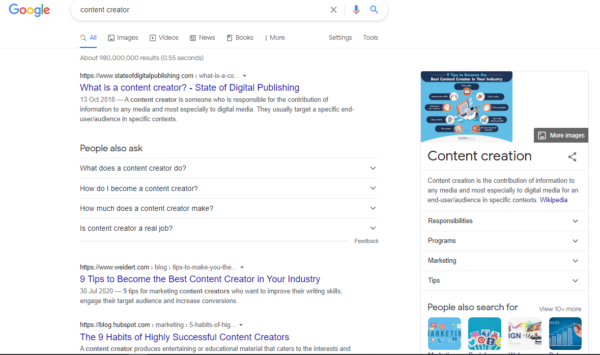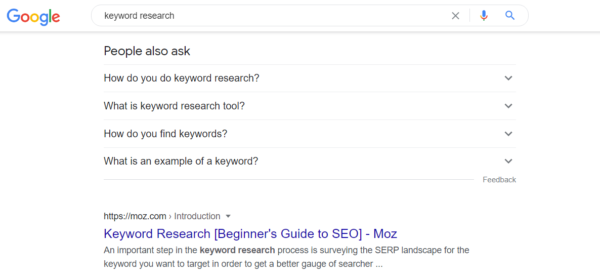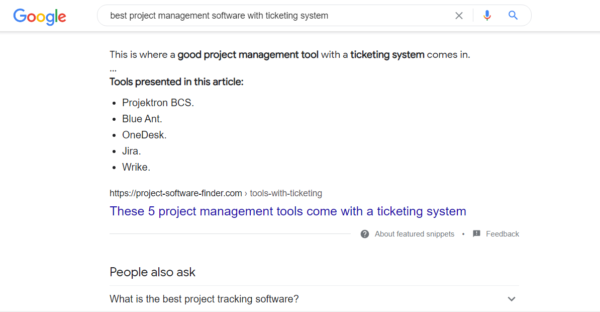A whopping 3.8 million Google searches are conducted every minute. And the search engine works hard to provide the most satisfying answer to every query. The key to using these searches to your advantage is to understand user intent.
User intent simply refers to the motive behind an internet search. In other words, you should be able to predict what the user is really after when they consult a search engine. So, why do you need to know user intent?
Well, if you want to increase your brand’s reach through online marketing, you’ve got to pull traffic. And to do that, you’ve got to show Google that your website provides a great answer to user queries related to your product or service. And, to do that, you need to understand user intent.
Now, you don’t need to be a digital marketing wizard to understand user intent. Just read on, and we’ll show you how.
Table of ContentsWhy user intent marketing?What are the types of user intent?10 best practices for understanding user search intentFinal thoughts
Ready to do more business with email marketing?
Start your free 60-day trial today.
Email Address
No risk. No credit card required.
Learn more about our 60-day free email marketing trial.
Why user intent marketing?
Some website owners use paid rankings or online ads to buy their way to the top of the SERP, or search engine results page. However, when weighing costs vs. benefit, the more conventional — free — method of organic traffic is still the better online marketing strategy.
That being said, optimizing organic traffic goes beyond ordinary SEO tactics. Typical SEO techniques insist that you focus on how search engines work. But if you’re going to have a truly successful organic traffic run, you have to keep the searcher in mind as well. Top-ranking web pages adopt a user intent-based SEO strategy.
Sure, the use of keywords, strong backlinks, and catchy headlines will make your website look good and get users to swing by. But, it is one thing to entice readers to check out your website, while it is another to get them to stay. If your content doesn’t answer their questions comprehensively, the users will walk away. How do you feel when you open a YouTube video only to realize that the thumbnail was misleading? Totally not cool, right?
 Click baiting can not only disappoint and frustrate your readers but it can also cause them to not return to your site again.
Click baiting can not only disappoint and frustrate your readers but it can also cause them to not return to your site again.
You may have observed that such videos often have fewer views and more dislikes. It is a similar case with the web copy.
Moreover, a call to action (CTA) is usually placed in the midsection or final paragraph of web content. But if you clickbait users (that is if your content doesn’t deliver on the headline’s promise), chances are they won’t read long enough to come across your first CTA. And if readers keep bouncing, your website would not rank well.
That is why you need to know the searcher’s — the user’s — intent. And your content must deliver on its promise of being informative, engaging, educational, and fun. That would translate into a solid organic traffic performance and high conversion rates.
What are the types of user intent?
Think about how you personally use a search engine. Basically, you do one of three things:
Look a topic up, showing an informational search intentSearch for the link to a specific website, showing a navigational search intentLook for a product or service, showing a transactional search intent
Informational search intent
A user with an informational search intent Googles search terms like “content marketing techniques” to read recently published articles on the subject matter and get informed.
Navigational search intent
A user may just Google the name of an online retail platform with an intent to find the correct link to the platform, indicating a navigational search intent.
Most searches are done with navigational search intent. That is, a majority of users are looking for details of a product or service. And that’s why a search engine is such a great place to search for potential new customers.
Transactional search intent
A user with a transactional search intent searches terms like “best Black Friday smartphone deals” to obtain credible online resources on product discounts and such.
Sometimes, a commercial search intent may be referred to. But it is very closely related to the transactional intent and can be considered part of it.
Bottom line, optimizing for keyword intent will help you attract new customers.
10 best practices for understanding user search intent
Now you know why user intent marketing can be good for your business. Here’s how you can nail it.
1. Review other articles
Rest assured that dominating search results isn’t rocket science. You can start with a simple exercise: review top-ranking articles that cover your topic. Head over to Google and enter the keyword you want to optimize. Now, check out the highest-ranking web pages — the first five hits perhaps.
These articles made it to the very top because after a careful analysis of keyword intent, Google figured they were the most relevant.
For example, the term “content creator” could mean a writer or a video creator. But if you look it up, the highest-ranking hits are all about writing. This means Google realized that most of the time, when people look up “content creator” they mean “content writer” and not “video creator.”
 Search engine results page (SERP) for user intent search “content creator.”
Search engine results page (SERP) for user intent search “content creator.”
So if “content creator” is your focus keyword, you have to know what it means to your target user. In short, know the trend before you write a post.
Now, as you review the high-ranking articles, ask yourself these questions:
What specific details did they provide?How did they present those details? For example, what diagrams, images, and videos were used?What other keywords and keyword variants were featured?
With this information, you can start drafting a content brief for your web copy.
2. Discretion
It is often said people want the right answers, but they don’t always ask the right questions. This is also true with user searches.
Sometimes, searchers use ambiguous search terms. Take for example the keyword “ring.” It could mean a tech company, a jewel, an app, among others.
Also, the search term may deliberately have multiple intents. So for certain keywords, the search results comprise different themes.
What should you do in these instances? Pick one of the main themes — possibly the one that closely matches your interest — and align your post with it.
3. Check out the Google question box
Google’s SERP has many features: from featured snippets to the People also ask (PAA) box. The PAA box can be a great place to look for search intent. It is a sample of frequently asked questions (FAQs) related to a topic. And, it is very popular among users.
In fact, one effective SEO trick is using a couple of questions from the PAA box to form subheadings in your article. Then, you can proceed to provide the most accurate and precise answers to them.
This way, your post stands the chance of being featured in the PAA box. Moreover, the users who want to learn more will definitely follow the link to your website.
For example, looking up “keyword research” brings up the following SERP:
 SERP for user intent search “keyword research.”
SERP for user intent search “keyword research.”
Observe how the PAA box lists the specific things people want to know about the keyword.
4. Tag transactional info
We mentioned earlier that more often than not users are looking for a product or service. That is, whatever the user is searching for, usually, the endgame is to shop.
So, as you inform the reader, let them know that if they also have a transactional intent, you’ve got them covered.
A good way to do that is to:
Section your website appropriately: give the website a methodical design and let the reader know where to find whatBacklink to a product page or two Use CTAs if applicable: tell the reader how you want them to respond
5. Know your target audience
Aim to understand your target audience. It is a great way to figure out their search intent. Let’s say your audience is; busy small business owners with customer service issues. If you know this, you can almost correctly predict what they want. It may be something like “best project management software with a ticketing system.”
Now, you can narrow your content down to the specifics and incorporate as many details as needed. It also helps you avoid fluff that may very well repel your readers.
The image below shows a website that ranks number one for a software search phrase. It achieved this by adding a specific audience choice phrase to the target keyword.
 SERP for search “best project management software with ticketing system.”
SERP for search “best project management software with ticketing system.”
6. Observe consumer behavior
Who better to tell you what the user intent is than users themselves? You can make it a point to simply observe customer behavior.
Engage with your customers Ask them the questions that matterEmpathize with them
Some marketers use short surveys for this. Social media polls also work.
One advantage small businesses have over large-scale ones is their ability to deal with customers individually. You may be surprised to learn that their intents really represent the larger picture. Take advantage of that.
7. Google Analytics
If your previous articles did not rank well, ask Google Analytics to show you what the problem is. This is a free tool that websites use to track site visits, session time, bounce rate, and so on. In other words, it gives you insight into user behavior.
This tool can help you evaluate the returns on your investment. It shows you whether your current marketing strategy is working.
8. Third-party tools
If you still feel the need for assistance, many options are available. There are marketing tools that can help you optimize for search intent and up your game.
Google Keyword Planner, Google Trends, and other SEO tools would tell you the keywords people are searching. But optimizing for user intent requires a different set of tools.
9. Digital marketing experts
Digital marketing advisors are also willing to help you out. These specialists have ranked many articles on Google. And so, they know the tips, tricks, hints, and techniques of user intent. You could reach out to them.
10. Stay motivated
This is the most important step of all. You’ve got this. Don’t be too hard on yourself if you don’t meet your marketing goals all at once. You’re going to get there. Focus, work hard, press on, and you will make it.
Final thoughts
Gone are the days when domains could trick their way to the top of SERPs. Nowadays, everyone has to earn their place at the high table. You do this by generating high-quality content. As discussed, high-quality content in this case refers to posts that take user intent into account. In a nutshell:
User intent-based SEO strategy is an effective way to pull organic trafficClick baiting should be avoided at all costs because it’s bad news for your brandThere are three main types of user intents: informational, transactional, and navigational
To understand user intent,
review top-ranking articles that optimized your target keywordconsult Google Analytics to see how your website is performingknow your audience wellask your customersconsider consulting digital marketing tools and/or expertsdon’t give up
Once again, don’t be intimidated. Remember, Google is willing to give every website — including yours — a chance to shine. So strive to nail your target keyword with the tips you’ve learned today. Happy marketing!
The post What is User Intent? appeared first on Constant Contact.
Read more: blogs.constantcontact.com
